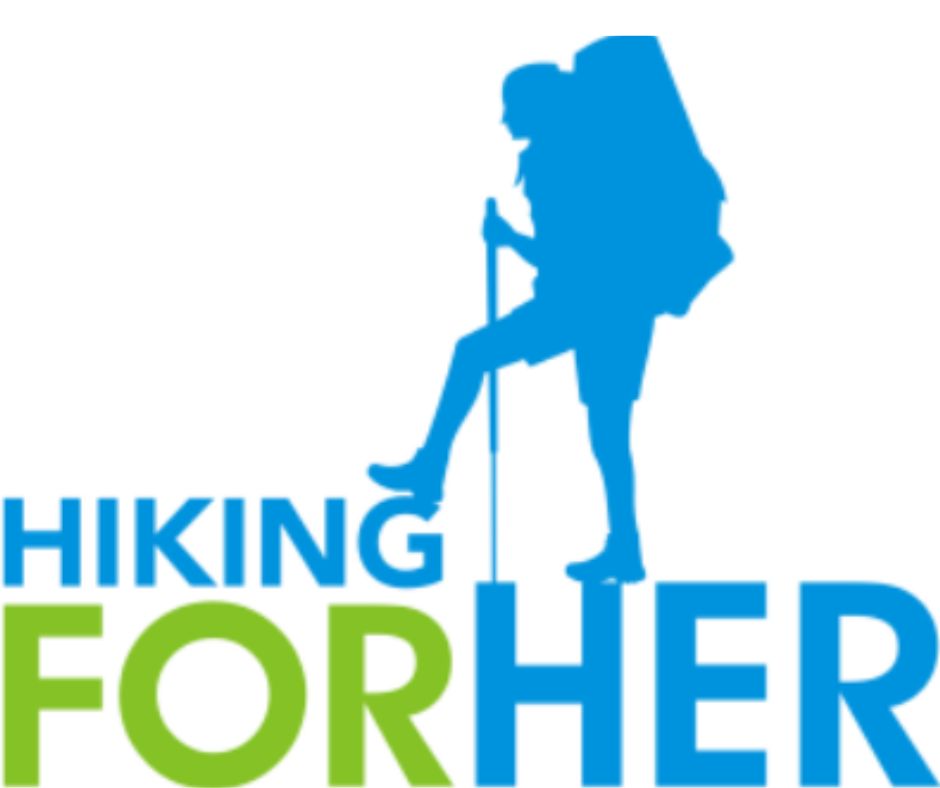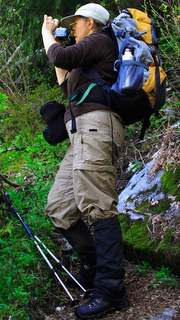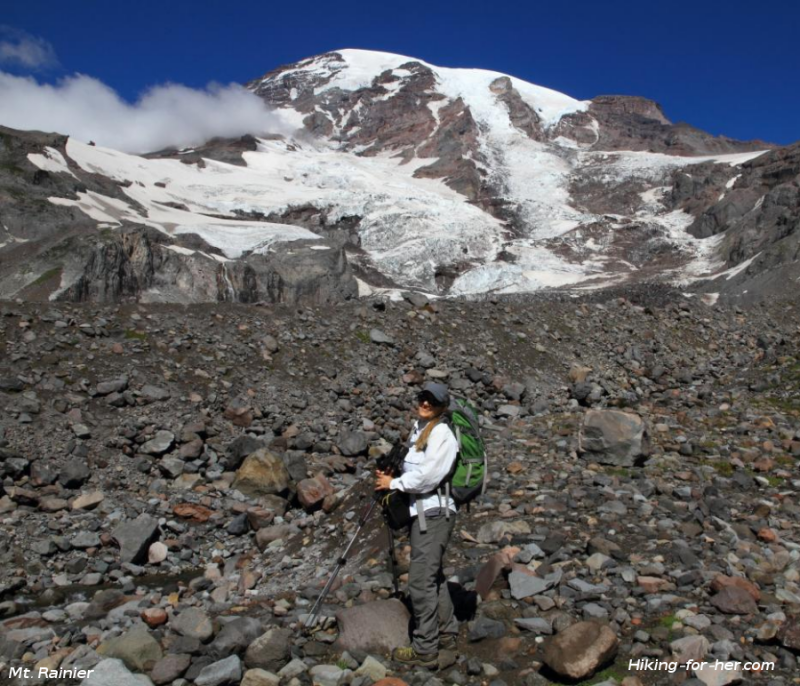Enjoy Happy Trails, the free monthly newsletter from Hiking For Her
Receive a free resource: "Hiking Layering System Explained"
Neck Injury Prevention
For Hikers
By Diane Spicer
Before getting into neck injury prevention for hikers, let me ask you a question.
Is your neck ever sore after a hike?
Mine usually is.
And that bugs me.
I try to do everything right on the topic of neck injury prevention while hiking, and I'll share my approach in a moment.
But first, I think it's worthwhile to consider the structure of that delicate, highly mobile, but strong connection between your trunk and your skull. It will help us to understand why a sore neck and hiking might go hand in hand.
Because your sore neck in the absence of trauma (being hit by a falling branch, falling and striking your head, receiving a blow on the back, etc.) is not something to ignore.
Neck injury prevention for hikers:
it's all about
bones and muscles
You and a giraffe have the same number of bones in the neck.
Wild, isn't it?
The neck bones (cervical vertebrae) are 7 little (compared with farther down the spinal column) beauties stacked one atop the next.
- Here's a 3-D "rotate and zoom" view of them!
Because they are stacked, they are able to swivel and bend.
The tower of bones doesn't fall apart, because their joints are supported by soft tissues (muscles, tendons, ligaments, fascia).
In addition, these bones are asked to bear weight: they hold up your head with its big, impressive brain.
This is no small task! Your head weighs several pounds (more if you're taking a calculus or astrophysics class).
To mobilize the neck, you need muscles.
How many?
A few strap-like muscles named for where they attach to bones:
- sternocleidomastoid,
- semispinalis capitis,
- splenius capitis,
- longissimus capitis...
Whew! Big long names that indicate the fact that the muscle fibers run between the skull and the chest.
You also need a few larger muscles.
Test it out right now:
- Bring your right ear toward your right shoulder, and feel the strap like muscle running between ear and shoulder.
- See what I mean? That was your sternocleidomastoid (SCM) muscle doing what's called "lateral flexion".
And just one more fun name: your trapezius (a big trapezoid shape) attaches your head to your shoulders (among other things).
I'd say that's also a mighty important muscle to keep pain-free, wouldn't you?
And don't forget posture in our neck injury prevention for hikers!
Which brings us to an examination (it will be short and graded on a curve, I promise) of your posture as a hiker.
It's probably not a habit (yet) to check the position of your jaw in relation to your shoulders, but it's a fast way to see if you carry your head in a bent or forward position relative to your body.
Another thing to check:
Are you by any chance holding your shoulders high or in a hunched position?
If you don't want to check your own neck position, at least try this:
- On your next hike, make it a point to notice on-coming hikers on the trail.
- Do any of them have forward leaning posture, with their head or jaw leading?
If you do this long enough, you'll find yourself itching to stop them to share these neck injury prevention for hikers tips that I'm about to share (tell 'em it's a bit of tough love from Hiking For Her!).
Neck injury prevention for hikers: Strategies to use on the trail
So what's my point here?
Actually, I have two points, in the interest of neck injury prevention:
First, cold muscles at the start of a hike are a great way to sustain a neck injury.
I tend to hunch my shoulders and hold my neck stiffly when I'm cold. I try to pay attention to these bad habits, but sometimes I'm a few miles into a snowshoe trip or late fall hike before I realize what a pain in the neck I'm creating for myself.
So please tune into the amount of tension in your neck, and breathe deeply to let it go.
- Gently swivel your neck, bring your chin to your chest and then point up to the sky a few times before you put on your pack.
- Breathe from your belly, in slow long breaths.
Tip: I've found that keeping my neck warm with a fleece wrap around scarf helps avoid muscle tension.
This, in turn, aids in neck injury prevention.
I also use this type of scarf on cool summer mornings, and to fall asleep without hunching up in my sleeping bag on chilly evenings.A second important point
Osteoarthritis (the "wear and tear" type, not the inflammatory rheumatoid type) shows up in neck joints in most women sooner or later.
Here's where the proper pack, with properly adjusted straps, is vitally important.
- If your backpack is tugging on your neck throughout your hike, pulling the bones out of normal alignment, you're going to aggravate any arthritic grinding or soreness you may already have.
- Take the time to find a great fitting pack, and be diligent about adjusting the straps each time the season turns (more or less clothing, carrying more or less gear, means the pack will fit differently).
- Read my tips for hiking with osteoarthritis.
- Consider switching to a lumbar ("fanny") pack for day hiking.
- Wear cargo shorts (with tights underneath in cooler weather) whenever possible, utilizing the spacious pockets for snacks and ten essentials to lighten the load on your back.
Best advice for neck injury prevention for hikers
Neck injury prevention for hikers also includes avoiding trail hazards.
- Don't
step abruptly into holes because it will jar your neck. Easier said
than done, right? Let someone else go first on the trail and watch their feet!
- Pay close attention when descending steep slopes or crossing talus slopes. Test the rocks for tipsiness or instability with your body weight; you don't want your feet taken out from beneath you with a side effect of whiplash.
- When crossing streams, be on the lookout for deep holes which will cause you to grope for the bottom while craning your neck. I usually wear water shoes or sandals when crossing streams, so that I can "feel" my way along better, thus protecting my neck from sudden jarring.
- Use your trekking poles to probe ahead on uneven terrain, investigate piles of uneven sized rocks, and to create balance on tricky footing.
If you're on a long hike, swing your head from side to side occasionally, bringing more blood to the area and relieving tension on neck muscles. Making these little self care rituals a part of your hiking routine goes a long way toward neck injury prevention for hikers.
And please! Avoid my bad habit: thrusting my jaw out in front, trying to catch glimpses of what's ahead on the trail.
- I have to consciously remind myself to "do the turtle thing" (bring my head into alignment with my shoulders.)
When you take a rest break, remember to bring your fingers to your neck muscles and knead gently.
- Yawn widely, grimace, hang your head as your fingers knead the soft tissues. (Warn your trail companions first!)
If you're sleeping on the ground during a backpacking trip, create a neck roll or pillow with extra clothing.
- Or bring along an inflatable pillow.
- Use a good sleeping pad, too. By supporting your spine, you help pull your neck into correct alignment.
One more tip: Consider adjusting your hiking pace. Back off if you're going fast, or try for a more consistent pace that your neck can "settle into" without strain.
In short, baby your neck BEFORE it starts to hurt.
- This is especially true for women over 40 years of age.
Already experiencing neck pain while hiking?
Neck injury prevention for hikers becomes higher on your list if you've already experienced neck pain.
Have you tried an over-the-counter gel or ointment preparation for pain relief?
Mineral Ice is my personal favorite because it creates instant relief from inflammation, but its strong odor does not recommend it for use in bear country.
I enjoy the cooling sensation it provides to my hot inflamed areas.
One word of warning: Don't rub your eyes or put your fingers in your mouth until you've washed this product off your hands.
Take a look at it here:
Mineral Ice Pain Relieving Gel, 3.5 ozAnother approach, in conjunction with Mineral Ice, is to hunt for your trigger points and spasms with your fingers.
- Place the flat parts of your fingertips on the back of your neck.
- Gently press into the muscles, working your way to the front of your neck.
- Note the places where soreness or outright pain occur. Those are the spots you want to linger on, gently knead and press.
- Don't be afraid to use a lot of pressure on neck muscles, but be aware that you have nerves and blood vessels there as well.
If you experience a buzzy sensation or feel light headed, that's enough neck work for the moment.
Neck injury prevention for hikers:
a summary
Protect your neck while hiking by becoming mindful of these things:
- Your posture (hunched over, bad; erect and neck not craning forward, good).
- Your backpack's fit.
- Your hiking pace.
- Your neck's feedback: soreness, spasms, tightness, tingling.
Paying attention to neck injury prevention for hikers is a great investment in your hiking future!
Begin to make some of these recommended adjustments today, and bid good bye to neck pain as a hiker.
Home page > Best Hiking Tips > Injury Prevention >
Neck Injury Prevention




